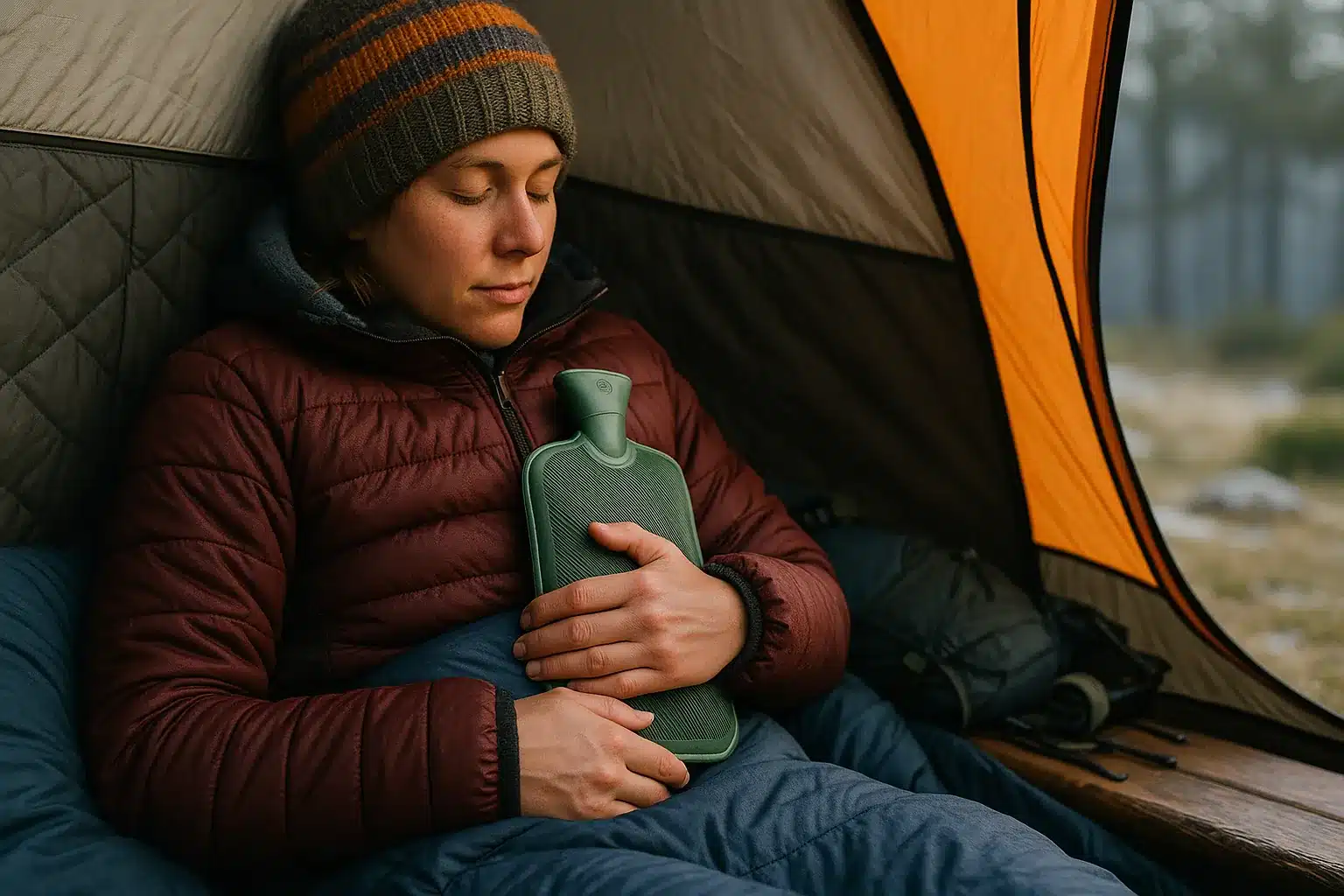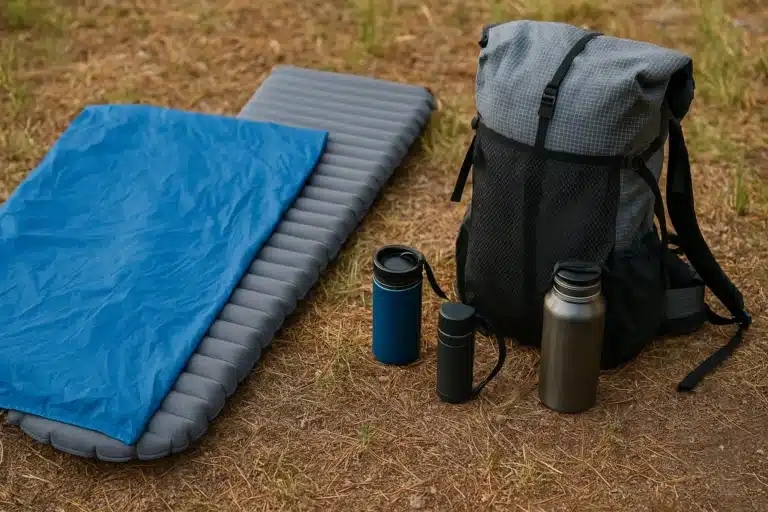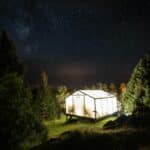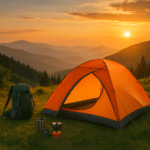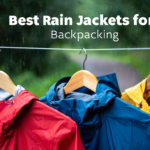Category: Camping & Hiking| Type: Guide | Focus: Cold Weather Camping | Time: 12 m
Last updated: May 2025
Introduction: Why Your Tent Feels Colder Than Outside
Ever wondered why your tent feels like a refrigerator at night—sometimes even colder than the outside air? The answer lies in radiant heat loss, poor insulation, and condensation management. Tents aren’t designed to be cozy cabins—they’re weather barriers, not thermal insulators.
But don’t worry. Whether you’re camping in shoulder season or high elevation, there are proven methods to keep your tent warm at night—without hauling 10 extra pounds of gear. These cold weather camping tips will transform your overnight experience from shivering to comfortable. Master how to stay warm in a tent with these cold weather camping tips for 2025.
1. Insulate the Ground Beneath You to Keep Tent Warm
The cold from the ground is your number one heat thief. Even with a warm sleeping bag, if you’re lying on a thin air pad, you’ll feel that chill creeping up through ground insulation camping layers.
What to Do:
- Use a closed-cell foam pad (CCF) underneath your air pad for added insulation
- Aim for R 4.0 for 30–40°F nights; R 5.0–6.0 for 20°F or below, even in 3-season conditions
- Lay down a reflective emergency blanket or a foam puzzle mat under your sleeping area
- Add a footprint or extra tarp under the tent to block cold air from seeping in below
Pro tip: Even a cheap windshield sunshade can add warmth when placed under your sleeping bag as part of your tent insulation hacks arsenal.
2. Reduce Empty Space Inside the Tent
Smaller tents = easier to heat. Large tents trap more cold air, especially if you’re the only one inside, making the question of how to stay warm in a large tent particularly important.
What to Do:
- Choose a tent size just big enough for you and your gear
- Store backpacks and unused gear inside to fill space
- Use a tent liner or inner mesh room to create a second air layer
- Consider a sleeping bag liner for extra warmth in your core sleep system
3. Use a Hot Water Bottle Camping Hack (Safely)
A classic hiker trick that works wonders: heat water, pour it into a leak-proof Nalgene, and tuck it into your sleeping bag 15-30 minutes before bed. This hot water bottle camping hack is a game-changer for sleeping bag warmth. Alternatively, use a metal bottle (e.g., Klean Kanteen) to avoid plastic odor from hot water in Nalgene bottles.
Best Practices:
- Use boiled water and seal tightly
- Place it near your core or between your thighs, not just your feet
- Use a sock or fabric pouch to avoid direct skin contact
Caution: Always test the seal. If it leaks inside your down bag, it’s game over.
4. Eat a High-Calorie Snack Before Bed
Warmth starts from within. Your body burns calories to generate heat, so give it fuel before sleeping—an essential part of cold weather camping tips.
What to Eat:
- Peanut butter
- Trail mix
- Energy bar or jerky
- Instant oatmeal with butter or coconut oil
Avoid alcohol—it may make you feel warm but causes blood vessel dilation and increases heat loss, counteracting your efforts to keep tent warm at night 2025.
5. Upgrade Your Sleeping Bag or Liner
Even a solid tent setup won’t help if your sleep system underperforms when you’re trying to achieve best tent insulation for freezing temps. Synthetic liners (e.g., Thermolite) can boost warmth by up to 15°F but add 10–14 oz compared to silk’s 7–10 oz.
Key Features to Look For:
- Comfort rating for the expected low temps, not just the “extreme” limit
- Mummy shape to reduce air space
- Down insulation for best warmth-to-weight ratio
- Add a fleece or silk liner to boost warmth by 5-10°F
Budget tip: Instead of buying a new bag, get a thermal liner for $30-$50 and instantly boost your bag’s warmth. For more budget options, check out our guide on Budget-Friendly Hiking Socks That Last that can complement your sleeping system.
6. Block Wind and Drafts for Better Tent Warmth
Even a well-pitched tent loses heat if wind is funneling in through the vents or around the base—a key factor in choosing a warm campsite.
How to Minimize It:
- Pitch your tent low and taut to the ground
- Stack rocks or snow around the base perimeter
- Use guy lines and low-hanging vestibule flaps to prevent air circulation under the tent
- Face tent doors away from prevailing winds
These campsite selection tips make a significant difference in maintaining tent temperature.
7. Dress Smart for Sleeping
More isn’t always better when it comes to sleep clothing. Overdressing can lead to moisture buildup, which will make you colder—proper layering for camping is crucial.
Layering Strategy:
- Base layer: moisture-wicking (e.g., merino or synthetic)
- Mid-layer: light fleece or insulated jacket
- Clean, dry socks
- Beanie or buff for head warmth (10–20% of heat loss occurs through the head)
Avoid: cotton, damp clothes, overly tight socks that might restrict circulation
8. Use Tent Heaters (With Caution)
In certain conditions, tent-safe heaters can be a useful short-term solution, but tent heater safety must be your priority. Catalytic heaters require at least 4 in² of ventilation (e.g., open vent or unzipped door). USB hand warmers may cause burns if left against skin for hours. Note: Catalytic heaters require fuel canisters (~$5–10 each), adding to cost.
Types of Safe Tent Heaters:
- Catalytic heaters like the Mr. Heater Little Buddy (with good ventilation)
- Battery-powered heating pads or USB hand warmers placed inside sleeping bags
Never use propane or butane heaters in enclosed tents without ventilation—carbon monoxide is deadly. When considering safe tent heaters for camping, always prioritize models with automatic shut-off features.
9. Warm Up Before You Sleep
Your sleeping bag keeps heat in—it doesn’t create it. If you get in cold, you’ll stay cold, which is why understanding how to stay warm in a tent begins before bedtime.
How to Pre-Warm:
- Do a set of jumping jacks, squats, or walk briskly around camp
- Sip warm tea or broth (non-caffeinated)
- Use a warm compress like a heated rock wrapped in fabric
Just don’t sweat—wet layers will cancel out any gains and contribute to radiant heat loss.
10. Choose the Right Campsite
Your location has a major impact on nighttime temperatures and is a fundamental aspect of budget ways to keep tent warm. Note: East-facing slopes are less effective in cloudy conditions when morning sun is delayed.
Ideal Site Features:
- Not in low-lying areas or valleys (cold air sinks)
- Natural wind barriers like boulders or dense trees
- East-facing slope (sunlight hits sooner in the morning)
Avoid open ridges and proximity to water, which increases humidity and dew.
Insulation Methods Comparison
| Method | Cost Range | Weight Impact | Warmth Boost | Best For |
|---|---|---|---|---|
| Foam Pad | $15-45 | Medium (8-16 oz) | +5-10°F | Ground insulation |
| Emergency Blanket | $3-10 | Negligible (2-4 oz) | +3-7°F | Reflective barrier |
| Thermal Bag Liner | $30-80 | Light (7-12 oz) | +5-15°F | Core warmth |
| Hot Water Bottle | $10-15 | Medium (5-8 oz empty) | +3-8°F | Targeted warmth |
| Tent Heater | $45-120 | Heavy (1-3 lbs) | +10-20°F | Extreme conditions |
Use Chemical Warmers or Safe Candle Lanterns
What to Do: Place disposable chemical hand warmers (e.g., HotHands, $1/pair) inside your sleeping bag near your core or feet for 6–8 hours of heat. Alternatively, a UCO candle lantern ($25, 6 oz) can raise tent temperature by 3–5°F in a ventilated 2-person tent.
Best Practices: Use warmers in a breathable pouch to avoid direct skin contact. For candles, ensure 4 in² ventilation and place on a stable, non-flammable surface.
Best for: Snow camping or emergency warmth.
Caution: Never leave candles unattended; extinguish before sleeping.
Use Cases: What Works in Real Conditions
- Yosemite’s Tuolumne Meadows in October (35°F): Reflective blanket + Nalgene bottle kept camper warm in a 3-season MSR Hubba Hubba with a 30°F down bag.
- Utah’s Zion high desert in March (40°F, windy): Beanie + rock wind barrier + 2-person Big Agnes Copper Spur UL2 made a difference.
- Early spring in Appalachians” → “Appalachian Trail in Georgia, April (38°F): Thermolite liner + merino socks + peanut butter snack prevented wake-ups in a 3-season REI Half Dome 2.
- Snow camping in Colorado’s San Juans (25°F): HotHands warmers in my bag and a UCO candle lantern in my ventilated Nemo Kunai 2P kept me cozy.
These strategies aren’t theoretical—they come from thousands of backpackers sharing what actually works for keeping tent warm at night 2025.
Conclusion: Warmth = Planning, Not Just Gear
With budget ways to keep tent warm, like reflective blankets and calorie-rich snacks, you’ll sleep soundly even in near-freezing temps. With the right combination of smart layering, insulation hacks, and heat management, you can sleep comfortably even in 30-40°F nights—or colder.
Try layering a few of these tactics on your next trip, and you’ll notice the difference before the sun sets. For additional gear recommendations, check out our guide on DIY No-Sew Sleeping Bag Liner which complements these warming strategies perfectly.
Looking to protect your tent from other elements? Our article on How to Repair Your Tent in the Field will help ensure your shelter stays intact in challenging conditions.
FAQ: Keeping Your Tent Warm
Q1: What is the best R-value for cold-weather camping?
Aim for R 4.0 or higher for 3-season use. Winter camping may require R 6.0+.
Q2: Is a 20°F sleeping bag enough for 30°F nights?
Yes, but only if you’re using insulation under you and dressed properly. Comfort rating matters more than survival rating.
Q3: Will a tent heater work in freezing temperatures?
Some can help, but rely on passive warmth methods first. Heaters are emergency tools, not primary solutions.
Q4: What’s the safest way to use a hot water bottle?
Use a Nalgene with boiling water, seal tight, wrap in fabric, and never place directly against skin.
Q5: Why do I feel colder in my tent than outside?
Poor insulation, trapped moisture, and lack of radiant barriers are the main culprits. Manage ventilation and ground insulation.
Q6: What’s the best sleeping bag liner for warmth?
A $30–50 fleece or Thermolite liner adds 5–15°F to your setup.
Q7: What’s the best budget way to keep tent warm in snow?
Chemical hand warmers ($1–2) or a UCO candle lantern ($25) add warmth without breaking the bank.
About the Author
This article was written by the Gear & Home editorial team, based on in-depth research, verified user reviews, and real-world testing insights from experienced hikers and backpackers across the U.S.
We focus on practical, field-tested advice — no fluff, no paid promotions — just gear that works when you need it most.

